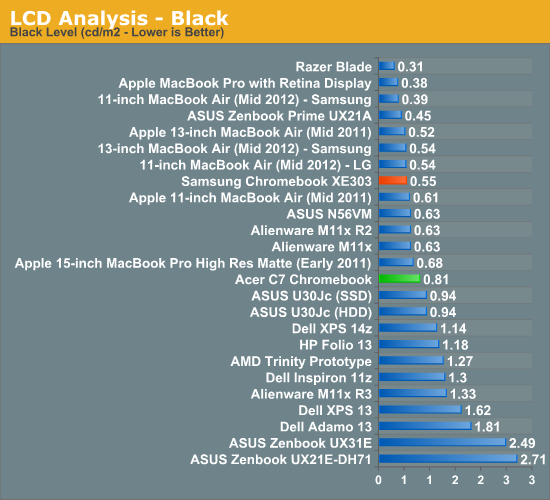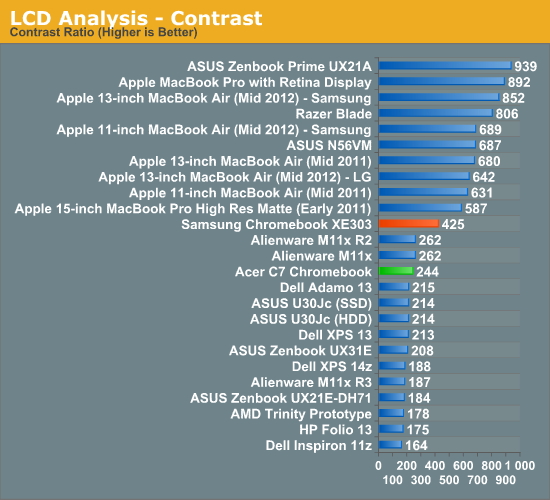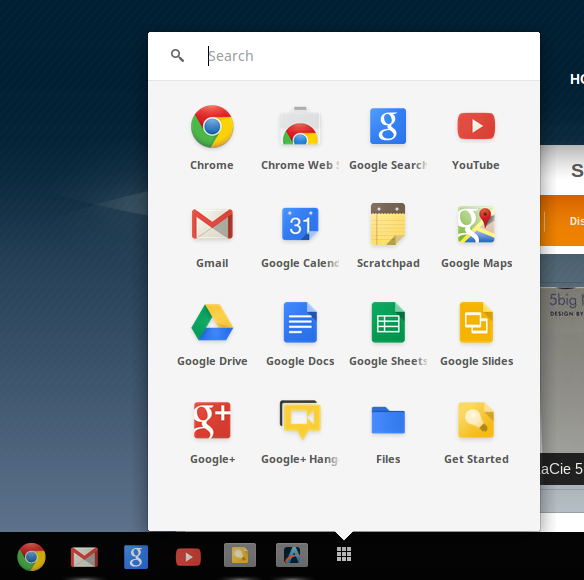Acer C7 Chromebook Review
by Jason Inofuentes on January 21, 2013 12:30 PM ESTDisplay
The display is typically bargain bin stuff, though certainly a step behind the Samsung's panel. The resolution is a ho-hum 1366x768, and the viewing angles are abysmal. My colorblindedness makes it hard to discern the light blue hue that is all the rage in modern operating systems for selected text, but here it is utterly impossible if the vertical viewing angle is off by more than a few degrees. Distortion appears within a few degrees of viewing the display from any horizontal angle, but this isn’t a big screen for showing off your favorite movie; so, we’ll cut it a modicum of slack. It’s a bad display. Unless all you’re going to do is sit right in front of it and type.



Usability

Anand covered the details of Chrome OS before, and I won’t go into any great length here. The limitations of the OS are easy to overlook for anyone that spends most of their time in a browser. Any number of web services can fulfill the role of many standalone pieces of software, both for entertainment and productivity purposes. That includes image manipulation, a must for web publishing, though handling RAW files wasn’t a pretty experience, even with the cloud to help me out. Not all music services have a web player, so there’s some limits there, but there are enough options to choose from.

Chrome OS: Tabs on tabs on tabs
So, there are limits to what this OS can do for you. But are there ways to get around the limits of the browser? You bet. Chrome Remote Desktop is like any other screen sharing software, it allows you to view and manipulate another PC. The big difference here is that it all happens within the browser window.
The quality of the network connection is the biggest factor in whether the screen sharing experience will be good or abysmal. Connecting the Acer C7 to my MacBook Pro on the same network was a good best case scenario and showed that inputs are received with minimal latency, and responses are snappy, so long as you’re not doing anything too drastic. The stream from the host PC is only updated based on changes, so while typing the inputs are received and shown on the client screen almost instantaneously. But switching between full screen apps on the MBP showed some lag and a rather low frame rate.











63 Comments
View All Comments
JasonInofuentes - Tuesday, January 22, 2013 - link
In the terminal I was able to run cat /proc/cpuinfo during lots of scenarios and the output was always 800MHz. Since there's no way to run monitoring programs in a Chrome OS instance, and since the clock and voltage tables aren't exposed as they were in the Samsung Chromebook, we don't know whether this is an intermediate state, but based on the results I'm confident of that figure as the max clock.Exophase - Tuesday, January 22, 2013 - link
Are you sure it said 800MHz for both cores? Can you test it while running a workload you know is pegging the CPU indefinitely, preferably a backgrounded command line task like dd?Frankly I think the scores don't really add up for 800MHz. Look at what the lower end Samsung Chromebox achieves here:
http://www.tomshardware.com/reviews/chromebox-chro...
That uses a Celeron B840 which is clocked at 1.9GHz, and since it isn't running on a battery they'd have no reason to underclock it. If you scale its Sunspider score of 296ms from 1.9GHz to 1.1GHz you get 511ms, which fits perfectly with the values you got in this review. At 800MHz you would expect a number closer to 700ms. This is assuming linear scaling, but given Sunspider is single threaded and these are fairly low clocks for both I doubt you'd get much worse. I also doubt that V8 made huge improvements in its x86 performance since then.
sonnyrao - Sunday, January 27, 2013 - link
Hi, it is definitely a 1.1Ghz processor, but has cpu frequency scaling enabled like any other modern system. I'm not sure what scenarios you ran but looking at /proc/cpuinfo isn't really the best way to determine frequency. At the minmum, you should be looking at /sys/devices/system/cpu/cpu*/cpufreq/scaling_cur_freqbut running something like powertop or i7z would be even better (you can copy them onto the C7 from another 32-bit Linux system)
I'd do something like this, put it into dev mode, open a window for crosh (ctrl-alt-t) and run the shell from there sudo to become root
then run
watch -d cat /sys/devices/system/cpu*/cpufreq/scaling_cur_freq
and then run your benchmarks in another window.
jabber - Tuesday, January 22, 2013 - link
I've been trying out Lenovo Q180 Nettops recently. The ones I've been rolling out have the top end 2.1Ghz Atom in them, with 4GB of ram and a HD6450 GPU in them.Tally this together with a Sandisk Extreme 120GB SSD and the computing experience is pretty good. In all the usual computing tasks I couldn't tell it was an Atom based machine. It felt as fast and fluid as any full size x86 PC I have around. I've rolled a few of them out to small businesses and feedback has been excellent.
The problem with Atom is that makers feel they have an excuse to pair them up with even crappier hardware. Throw in an Atom chip with some decent supporting hardware and you have a pretty good low power setup.
lmcd - Saturday, January 26, 2013 - link
The graphics tied with Atom are probably the most hindering aspect.max347 - Tuesday, January 22, 2013 - link
Great review!I think the pics could use a little less bokeh though :-)
nathanddrews - Tuesday, January 22, 2013 - link
LOL - first thing I thought of. DOF is cool, but not if you can't even tell what's on the IO panel.JasonInofuentes - Wednesday, January 23, 2013 - link
Fair enough, I'm trying to get a nice light set-up that would facilitate more bokeh-free shots, but in the meanwhile I'm generally just trying to keep people from seeing the mess my house is generally in. :) Thanks for the compliment.Jason
Notmyusualid - Wednesday, January 23, 2013 - link
And it was so dog dam slow, that I GAVE IT AWAY, as soon as I got back from my deployment in the USA.Really, it gave me chest pains waiting for it to do anything.
I tried upgrading the RAM, and that made very little difference.
I realised quickly that I was wasting my time.
The 10yr old niece was happy to receive it though....
dj christian - Thursday, January 24, 2013 - link
Justin where did Anand cover the Chrome OS? It would be nice if you could provide us with a link to it.Thanks!